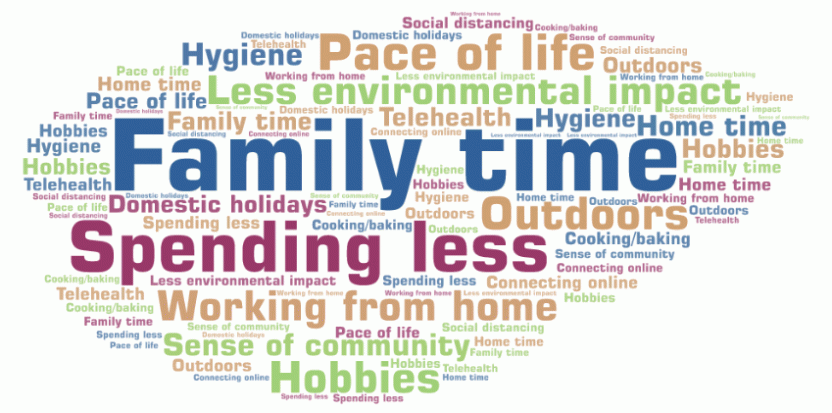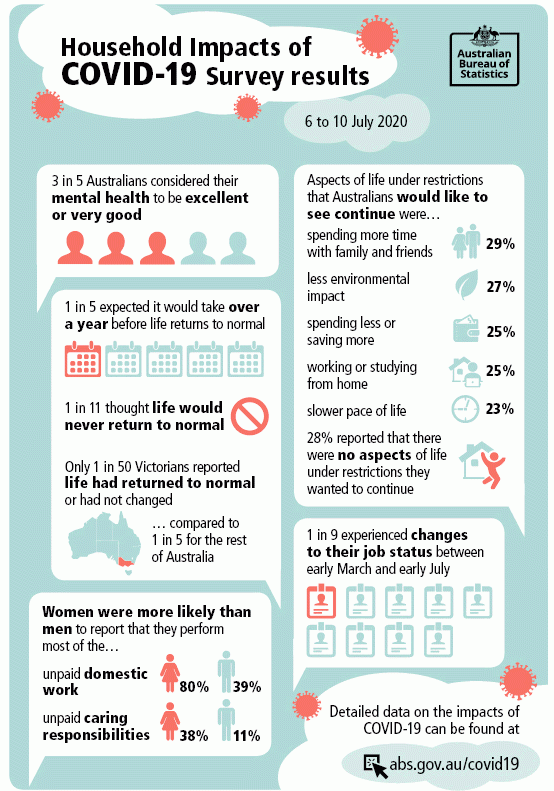About this issue
This publication presents results from the eighth Household Impacts of COVID-19 Survey, a longitudinal survey which collects information from approximately 1,000 people fortnightly via telephone. This was the last of eight fortnightly cycles with the same panel and was conducted between 6 July and 10 July 2020. A monthly collection with a new panel is planned from August 2020.
The eighth cycle collected information on:
- life after COVID-19 restrictions
- unpaid care and domestic work
- mental health and related services
- job status.
The scope of the survey was persons aged 18 years and over in private dwellings across Australia (excluding very remote areas).
About this collection
This survey is designed to provide a quick snapshot about how Australian households are faring in response to the changing social and economic environment caused by the COVID-19 pandemic. Each cycle has collected information on different topics.
Results from the earlier Household Impacts of COVID-19 Surveys can be found using the following links:
- Household Impacts of COVID-19 Survey 1–6 Apr 2020 (released 20 Apr)
- Household Impacts of COVID-19 Survey 14–17 Apr 2020 (released 1 May)
- Household Impacts of COVID-19 Survey 29 Apr–4 May 2020 (released 18 May)
- Household Impacts of COVID-19 Survey 12–15 May 2020 (released 29 May)
- Household Impacts of COVID-19 Survey 26–29 May 2020 (released 15 Jun)
- Household Impacts of COVID-19 Survey 10–15 June 2020 (released 29 Jun)
- Household Impacts of COVID-19 Survey 24–29 June 2020 (released 13 July).
At the time of the survey, initiatives in place to help reduce the spread of COVID-19 and support the economy included:
- international travel restrictions
- an economic stimulus package (12 March)
- border control measures for some states and territories
- shutting down of non-essential services and a second economic stimulus package (22 March)
- a Coronavirus Supplement announced on 22 March, to be paid fortnightly from 27 April to eligible income support recipients along with their usual payments
- a safety net package of $1.1 billion to expand mental health and Telehealth services, increase domestic violence services and provide more emergency food relief (29 March)
- social distancing rules and additional shutdown restrictions (20–30 March)
- free childcare for working parents (2 April)
- a JobKeeper Payment passed in legislation on 15 April and paid to employers to keep more Australians in jobs and support businesses affected by the COVID-19 restrictions
- easing of restrictions on elective surgery gradually from 28 April
- National Cabinet agreeing on a three-stage plan to ease restrictions (8 May)
- easing of restrictions in all states and territories from mid-May, with most between stage two and three at the time of the survey
- restrictions reinstated in regions of Victoria from 1 July related to new coronavirus clusters.
From 6 July to 10 July, when this survey was conducted, Victoria was identifying between 150 and 200 new cases daily. New South Wales numbers were steady between 10 and 15 new cases daily, while other states and territories were continuing to keep numbers low (no higher than three cases but often days with no new cases).
Due to the small sample size and associated high sample errors for this survey, it is not possible to meaningfully compare responses across all states and territories. Where possible, some analysis has been conducted comparing Victorian estimates with those for the rest of Australia.
Proportions marked with an asterisk (*) have a Margin of Error (MoE) >10 percentage points which should be considered when using this information. For more information about MoE refer to the publication Methodology.

